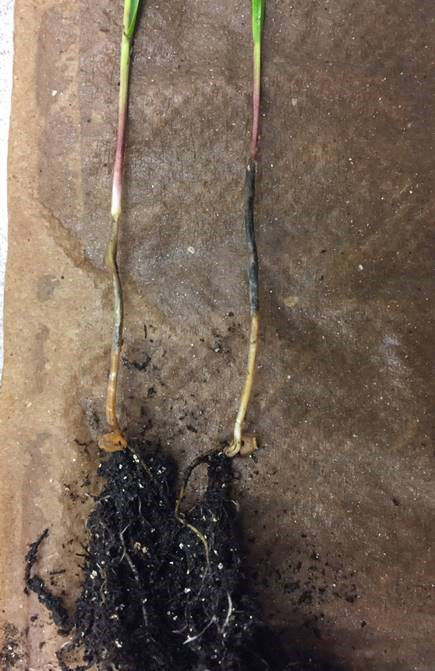What to Consider for a Replant Crop if Winter Wheat is Winter Killed
April 15, 2025
Winter wheat is a vital crop for many farmers, but it’s susceptible to the harsh conditions of winter. Seedling diseases may also be a result of harsh growing conditions (Figure 1). When winter wheat fails, the next decision is what crop should replace the failed wheat. Whether considering soybean, corn, or forage for replanting, key factors to consider include timing, soil conditions, pest management, and chemistry to help ensure a successful replant.

1. Timing: The Crucial Window for Replanting
Timing is a critical decision when winter wheat is winter killed. It determines both the crop choice and yield potential.
Soybean: Soybean can be planted later than corn, typically until late May or early June in most regions. Though the yield potential may be reduced with a late planting, soybean is a viable option if frost risks are avoided.
Corn: Corn requires an earlier planting for optimal growth. Late planting may not provide enough time for the crop to mature before the first frost, making it less ideal after a winter wheat failure.
Forage: For those with livestock, forage crops (like alfalfa or clover) are an excellent option. These crops have shown to tolerate later planting and offer a more forgiving and lower-input solution compared to corn.
2. Soil Conditions: Adjusting to a New Crop
After a winter-killed wheat crop, soil conditions may need adjustments for the next planting.
Soil Compaction: If the wheat had a dense root system, compaction may occur. To improve root growth for the new crop, tillage or aeration may be necessary.
Soil Fertility: Wheat depletes essential nutrients like nitrogen, phosphorus, and potassium. Conducting a soil test and applying the right fertilizers can help restore fertility and support the new crop’s growth.
Residue Management: Winter-killed wheat often leaves behind residue that can hinder planting. Managing this residue through tillage or no-till practices helps to ensure proper seed-to-soil contact.
3. Managing Pests and Diseases
Replanting requires careful management of any pests or diseases from the previous wheat crop that could carry over and affect the new planting.
Soilborne Diseases: Pathogens such as Fusarium and Pythium can survive in the soil and damage the new crop. Fungicides or soil treatments may be necessary to help protect emerging crops like corn or soybean.
Pests: Cutworms, which can be common in wheat fields, may affect the next crop. Pest control measures, such as insecticides or biological control, should be considered to manage pest populations. Additionally, if the previous crop was corn, corn rootworm females might have deposited eggs, which would be in the soil and upon hatching may impact a corn crop.
4. Chemical and Pesticide Considerations
When replanting, understanding chemical and pesticide factors is vital to avoid negative impacts on the new crop.
Herbicide Residue: Herbicide carryover from the winter wheat crop is a common concern. Some residual herbicides can persist in the soil, negatively affecting new crops. Farmers should check herbicide labels for any replanting restrictions and consider choosing crops that are resistant to previously used chemicals if necessary.
Pre-emergence Herbicides: Applying pre-emergence herbicides is essential for controlling early-season weeds, especially for crops like soybean or corn. Careful timing helps ensure that the herbicides don’t harm the newly planted crops.
Insecticides and Seed Treatment Fungicides: Pest and disease management may require insecticides or fungicides. Insecticides for specific pests like wireworms can be applied as soil treatments, while seed treatment fungicides can help protect against seedlings from soilborne diseases like Fusarium.
5. Financial and Risk Considerations
Replanting is an investment, and farmers must consider the costs of seed, fertilizer, pesticides, and labor. Additionally, late planting may result in reduced yield potential. Crop insurance policies may provide coverage for replanting, offering financial protection against potential losses. Farmers should carefully review their insurance options to ensure adequate coverage.
Conclusion
Replanting after winter wheat failure involves careful planning and decision-making. Timing, soil conditions, pest management, and chemical considerations all influence the success of the replant crop. With careful evaluation, farmers can transform a challenging situation into a productive season. By managing these factors effectively, farmers can make informed choices that lead to a successful replant and maximize yield potential.
Stetson Junek
Channel Agronomist
1110_529666